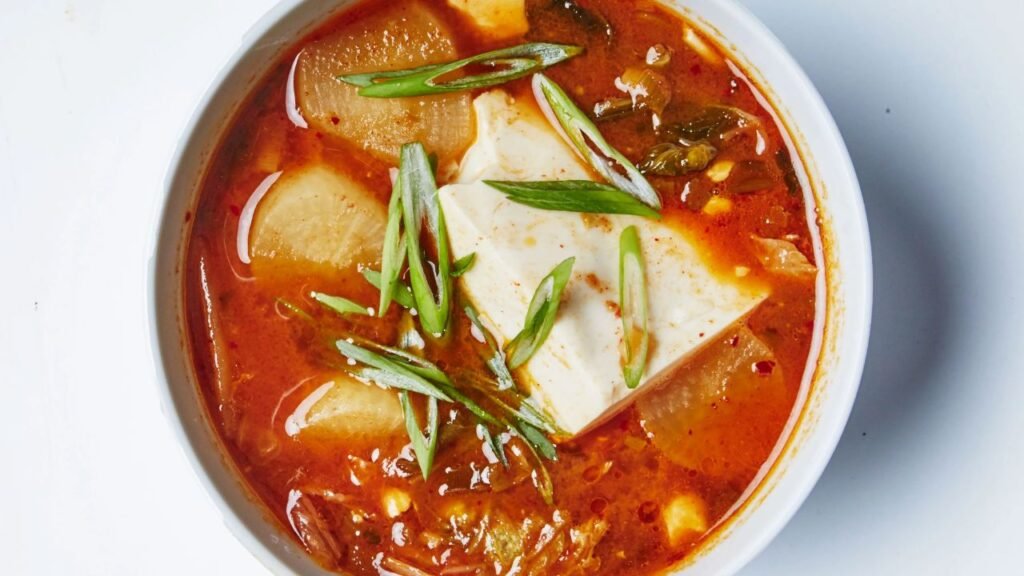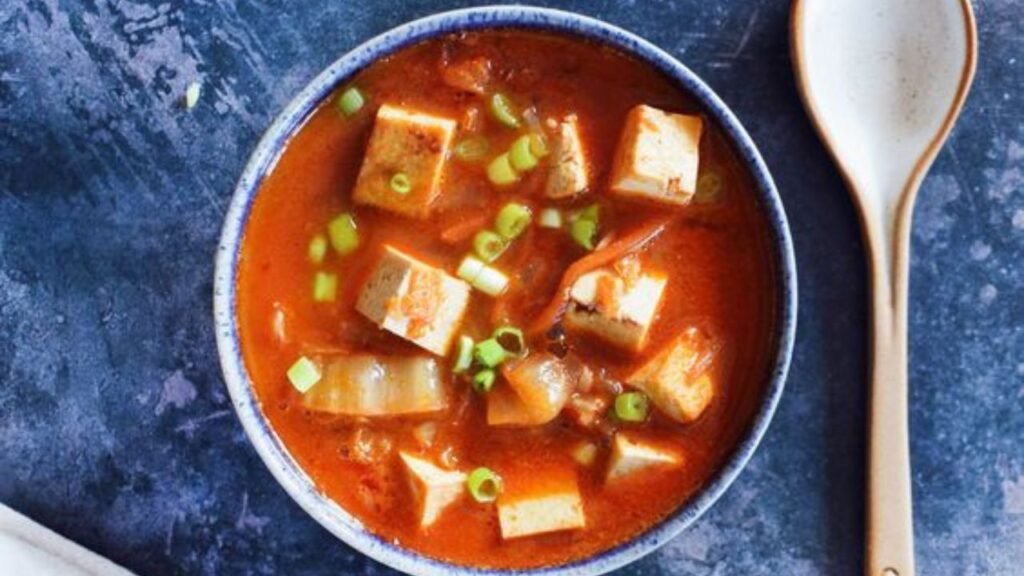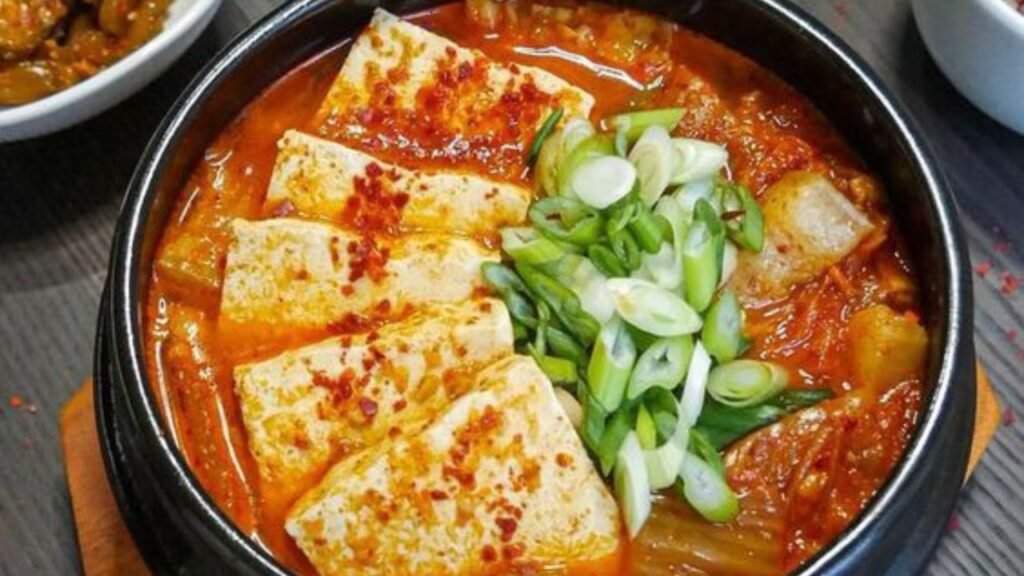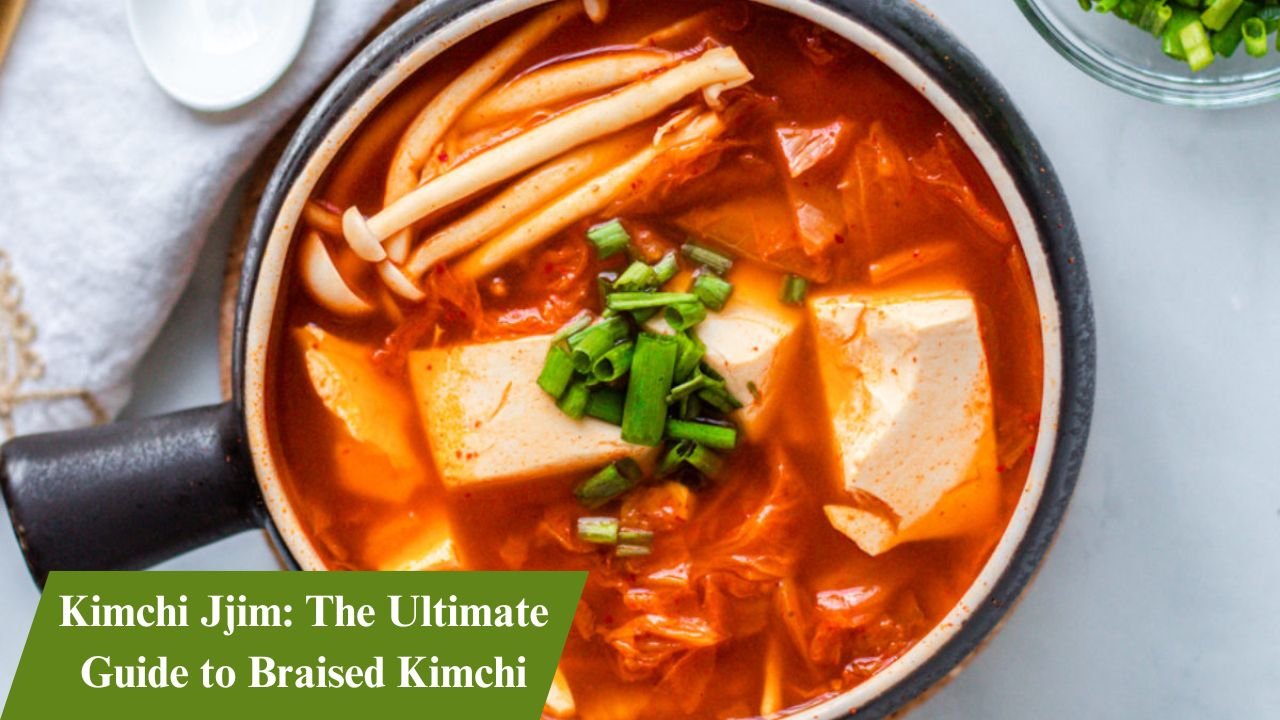Introduction
Kimchi Jjim, or braised kimchi, is a favorite Korean dish not because of any diversities in flavors but because of kinds of warmth. The dish holds an esteemed place within Korean food culture and explores the very art of fermentation and traditional ingredients.
Aged kimchi mukeunji, pork or mackerel, garlic, and gochugaru-the Korean chili flakes-these are the primary elements used here. Together, they make a singular flavor that’s savory at the same time as tangy. Cooking them takes the form of slow simmering to let these flavors come together. As a result, it’s hearty and satisfying.

In this comprehensive guide to braised kimchi, you’ll find:
- What makes Kimchi Jjim different from the myriad other kimchi-based dishes.
- How does fermentation enhance its flavor?
- How to make the dish with various cooking techniques; step-by-step guide
Step into the world of Kimchi Jjim to find out how to make this warm comfort food in your kitchen.
Understanding Kimchi Jjim
Kimchi Jjim is one of the traditional Korean dishes which differs from all other recipes related to kimchi in its preparation and taste. Unfolding from fresh kimchi recipes or plain kimchi stews, it incorporates much more slow braising in order to acquire fuller flavors and thick texture. The ingredient that differentiates it has been mukeunji or aged kimchi.
The demand for matured kimchi is crucial to reaching a perfect flavor intensity. As mukeunji ripens, its sourness and richness will become more overpowering, making the entire dish own an incredibly deep palate unmatched by younger counterparts. More specifically to this stage, the fermentation process does not just fade away the spice of the kimchi but also harmonizes savory aspects associated with pork or seafood ingredients often used in traditional Kimchi Jjim recipes.
In simple terms, Kimchi Jjim shows the ways through which aging helps transform simple ingredients into a comforting Korean dish.
Key Ingredients for Kimchi Jjim

The magic ingredient in the pot is its major ingredients; this might add some unique flavor from each ingredient. It’s what you will need:
- Napa Cabbage: It is the star of the show. These are fermented into aged kimchi. Such a process gives a deep, tangy very taste which can be absolutely indispensable to producing the authentic, traditional Kimchi Jjim.
- Korean Radish: Adds a slight crunch and a touch of mild sweetness to the dish, which balances the big flavors coming from the kimchi.
- Pork: Using it has been traditional as a protein component. Fatty cuts such as pork butt or scotch fillet are also favored because they stay tender and juicy even after being slowly cooked.
- Ginger and Garlic: These are the staples of Korean cooking, providing warmth and depth to the dish.
- Tofu (optional): For vegetarians or just for other purposes.
- Vegetables (optional): Mushrooms or zucchini can be added for variety.
It is a combination of ingredients that will give you a beautiful and satisfying meal that is ready to be adjusted to your liking!
The Role of Fermentation in Kimchi Jjim
Fermentation, for example, serves as the agent that develops the rich flavors of Kimchi Jjim. Here, Napa cabbage is used to create the aged kimchi dish with a distinctly acidic and salty flavor. Brining is the first step in fermentation. This is an immersion of napa cabbage in brine that removes all moisture and develops good bacteria inside the cabbage.
How to Brine Napa Cabbage
- Prepare the cabbage: Cut the napa cabbage in half lengthwise and clean it really well.
- Solution: Salt Water Brine Dissolve salt in water.
- Brining: Submerge the cabbage into this solution, and soak all leaves completely.
- Resting Time: Allow the cabbage to sit for a few hours, or indeed overnight, losing excess moisture and developing salty flavors.
Mukunji is the result of that process, deep-flavored aged kimchi forming the very heart of Kimchi Jjim, infusing the Korean favorite with depth and complexity.

Preparing Aged Kimchi for Cooking Kimchi Jjim
Among the two kinds, Mak Kimchi and Pogi Kimchi are the most sought-after.
- Mak Kimchi: Mak Kimchi is considered to be easy to prepare since its ingredients have already been pre-cut and mixed with all seasonings. Its uniformity may be advantageous for fast cooking provided one does not prefer a more balanced flavour that’s less intense.
- Pogi Kimchi: This whole-leaf kimchi wraps cabbage leaves around the seasoning mixture. Pogi’s complication gives it a richer taste and, consequently, is the favorite to those that want to be served braises with depth in flavor.
Preparing Napa cabbage for aging is an art in itself:
- Fresh Cabbage: Use fresh heads of Napa cabbage. No bruise or wilted leaves.
- Brining Process: The brining process gets some moisture out of cabbage, which is necessary to lend crispness to it and prepares it for fermentation.
- Seasoning: Dust richly every leaf of your chosen spice mix-this will make sure that flavor gets spread throughout the layers as it ages.
Patience and enduring all the maturing processes involved with such kimchi, you are going to end up with a more full-bodied profile that’s meant to perfectly be married to the enhancing of your Kimchi Jjim experience.
Cooking Methods for Kimchi Jjim: Instant Pot vs. Dutch Oven vs. Slow Cooker
Regarding cooking method, making this distinction will significantly affect the taste of your dish as well as how it textures out. Here’s a comparison of three popular methods:
Instant Pot Recipe
- Ingredients: Mix in aged kimchi, pork, garlic, ginger, gochugaru, and broth.
- Settings: “Sauté” the pot to get the meat’s flavor. Then switch over to “Pressure Cook” for about 30 minutes.
- Release: Quick release towards the end for softer texture.
Dutch Oven Recipe
- Ingredients: Soak aged kimchi with pork and seasonings in the pot.
- Cooking: Do everything over medium heat before covering and reducing to low.
- Time: Stir occasionally around 1 hour.
Crock Pot Recipe
- Ingredients: Alternate layers of aged kimchi and meat with seasonings in the slow cooker.
- Preparation Method: Place lid on and cook on low for 6-8 hours or on high for 3-4 hours.
- Texture: This should be the creamiest, most flavorful dish ever.
Each technique has an advantage, so you can serve your Kimchi Jjim in the manner most acceptable to your schedule and your kitchen.

How to Make Delicious Kimchi Jjim with Short Ribs and Savory Sauce
Although a pretty honest dish, I observed the Kimchi Jjim recipe to be notably clean and pleasurable. This recipe will help you collect a very tasty delicious dish.
Ingredients:
- 2 cups old kimchi
- 1 pound short ribs (bone-in for richer flavor)
- 1 tablespoon vegetable oil
- 4 cloves garlic, minced
- 1 inch ginger, sliced
- 2 tablespoons gochugaru, Korean chili flakes
- 2 tablespoons sugar
- 3 cups broth or rice water
- 1 bunch scallions, chopped for garnish
Instructions:
- Heat oil in selected pot over medium heat.
- Brown the short ribs on all sides, about 5 minutes.
- Add in the garlic and ginger. Saute until fragrant
- Add in kimchi, gochugaru and sugar. Stir well.
- Pour in broth, ensuring it entirely covers the ingredients.
- Close it and let it simmer for 60 minutes or until meat is tender.
Tips for Tender Meat:
- Use bone-in cuts for richer taste.
- Let it slow-cook for it to be most tender.
Or you can try Spicy Galbi Jjim for the next different flavor of this Korean dish with similar ingredients.
Share easy recipe for this tasty Korean dish and enjoy it as a comforting meal or shared experience with family and friends.
Common Variations and Substitutions in Making Kimchi Jjim
Kimchi Jjim is very versatile, and the variations are endless for different tastes and dietary needs. Here are a few:
- Mackerel Addition: To add a seafood flavor, use mackerel instead; it pairs well with aged kimchi sourness with depth
- Mushroom Boost: With mushrooms, the umami flavor will gain a chewy mouthful of food that is hearty and filling. Specific dietary requirements can be met without diminishing the taste; substitutions can be made
- Galbi Jjim Variation: Use short ribs instead of pork for a richer flavor. This variation is using an expensive texture in the food.
- Coconut Aminos Substitution: Use coconut aminos instead of soy sauce, so it is gluten-free. The taste remains to be umami, but it ensures that someone on the Whole 30 or a paleo diet can enjoy this comfort food too.
All these changes allow everyone to have their comforting dish without losing its character.

Serving Suggestions and Pairings with Other Dishes
There are many ways of serving Kimchi Jjim. That is what makes this comfort food interesting. Here are some of the best ways through which to enjoy this divine meal:
- Serve over Rice: Over a steaming bed of white or brown rice, spoon a generous portion of kimchi jjim. The flavors are absorbed by the rice to create a satisfying balance.
- Standalone Dish: Serve it plain to let the rich flavors pop. This is best suited for those nights when comfort food really is all you’re looking for.
Pair with side dishes that add a richness to the meal:
- Banchan (Korean Side Dishes): To add a freshness in the context of traditional banchan, serve it along with pickled radish, seasoned spinach, or cucumber salad.
- Savory Pancakes: Serve the kimchi pancakes on the side of the Kimchi Jeon for providing a fourth element of textural and flavor contrast.
These matchings turn Kimchi Jjim into a meal prep idea that really celebrates hearty flavors of Korean culinary tradition.
Storing and Reheating Leftovers: Tips to Maintain Flavor and Texture
To make Kimchi Jjim again after the first prep, heed these best practices for leftovers storage:
- Refrigerate leftover food portions: Use an air-tight container for any portion of Kimchi Jjim that you are saving. Refrigerate Kimchi Jjim up to 4-5 days. The flavors will only develop and get deeper with time.”
- Freeze for later use: It freezes even longer. Pack it in freezer-proof containers or freezer bags with some headspace. Kimchi Jjim can be kept fresh in the freezer for up to 3 months.

When reheated, be sure that you preserve the flavors and texture of the dish:
- Stovetop method: Over low heat, stir frequently until warmed through. If it seems too thick, add more water or spray.
- Microwave method: Use a microwave-safe dish, cover loosely, and heat in short intervals, stirring between each until hot.
With this, your leftover Kimchi Jjim will always be appetizing and filling each time you have a serving.
Conclusion
Take the chance to make your own homemade Kimchi Jjim. This comforting dish encourages you to experiment and make it your own.
- Use the tips from this guide to improve your cooking skills.
- Enjoy trying different ingredients and techniques to find what you like best.
Warm up on those colder days with all the deep flavors of braised kimchi. Enter a realm where Korean food never sleeps, and make it your mission to master Kimchi Jjim: The Ultimate Guide to Braised Kimchi to be included in your cooking arsenal! Now it’s your turn to embark on your culinary journey!
FAQ’s
What is Kimchi Jhim?
Kimchi jajim is a traditional Korean dish with fermented kimchi, usually made with aged kimchi for extra flavour. It has a special cultural significance in Korean cuisine, showing the depth that fermented ingredients can offer.
What are the main ingredients of kimchi jazim?
The main ingredients in kimchi jazim are napa cabbage, Korean radish, pork, ginger and garlic. Favorite ingredients like tofu and various vegetables can be added to enhance the dish.
How does the sauce affect the flavor of kimchi jjim?
Fermentation plays an important role in developing the flavor of kimchi jjim. The brining process of Napa cabbage absorbs salt and creates a rich flavor that lasts longer, helping to enhance the overall dish.

